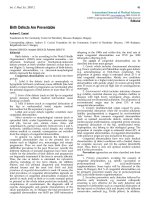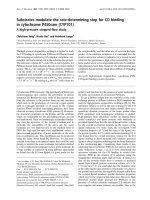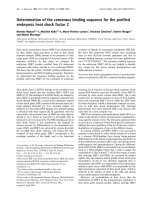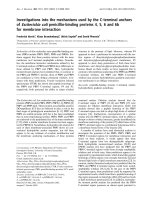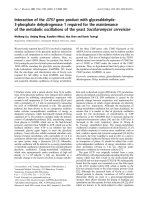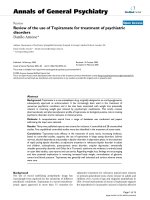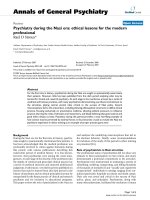Báo cáo y học: "Anesthesia for the High-Risk Patient" pps
Bạn đang xem bản rút gọn của tài liệu. Xem và tải ngay bản đầy đủ của tài liệu tại đây (112.49 KB, 1 trang )
In fewer than 300 pages, this book covers the complex
topic of anesthesia for the high-risk patient in a
comprehensive and complete way. Each chapter covers
the most up-to-date literature, providing a summary of
evidence as well as practical advice on how to approach
and tackle the multitude of diff erent problems of high-
risk patients. is book describes anesthesia as the
science of perioperative medicine, from preoperative
assessment to postoperative analgesia, via intraoperative
management.
In the fi rst chapters, the reader is led through the topics
of risk, epidemiology, and risk assessment. Statistical
concepts such as the number needed to treat and
absolute and relative risk reduction are also explained,
making the subsequent chapters even easier to under-
stand. Particular attention is given to cardiovascular and
respiratory risk; guidelines on how to manage cardio-
vascular risk in cardiac and noncardiac surgery are also
available, indicating which drugs to start, continue, or
stop before surgery. e book presents an extensive
explanation of the diff erent intraoperative approaches to
the high-risk surgical patient. A chapter not to miss is
defi nitely ‘Pharmaco-physiological approaches to the
high-risk surgical patient’, in which the patho physiology
of surgery is explained together with diff erent approaches
to identify, stratify, and treat high-risk surgical patients.
In this chapter, a literature review brings an up-to-date
view on hemodynamic intra opera tive optimization,
showing that this approach carries important advantages
to improve patient out comes. Importantly, this book does
not forget that the role of perioperative medicine is also
one of managing high-risk patients after surgery. Post-
operative complications are classifi ed and described, with
appropriate consideration given to the early recognition
and management of these problems. An interesting
chapter that completes a 360-degree view of anesthesia is
the one on the anesthesia of critically ill patients (‘ e
critically ill patient under going surgery’). Now that more
and more intensive care units are popu lated by anesthe-
tists, optimal anesthetic management of critically ill
patients requiring surgery is mandatory in order to provide
a continuum of care and the best chances for the patient
to recover from a critical illness.
In conclusion, this book could be placed on every desk
in the hospital and would be a valuable resource in the
hands of the junior as well as the more experienced
anesthetist.
Competing interests
AR has received lecture fees from LiDCO (Cambridge, UK). The authors declare
no other competing interests.
Published: 27 May 2010
© 2010 BioMed Central Ltd
Anesthesia for the High-Risk Patient
Maurizio Cecconi and Andrew Rhodes*
Anesthesia for the High-Risk Patient. 2nd edition. Edited by McConachie I. Cambridge, UK: Cambridge University Press;
2009. 302 pages. ISBN: 978-0-521-71018-3.
BOOK REPORT
*Correspondence:
Department of Intensive Care Medicine, St George’s Healthcare NHS Trust, London,
SW17 0QT, UK
doi:10.1186/cc9007
Cite this article as: Cecconi M, Rhodes A: Anesthesia for the High-Risk Patient.
Critical Care 2010, 14:312.
Cecconi and Rhodes Critical Care 2010, 14:312
/>© 2010 BioMed Central Ltd
